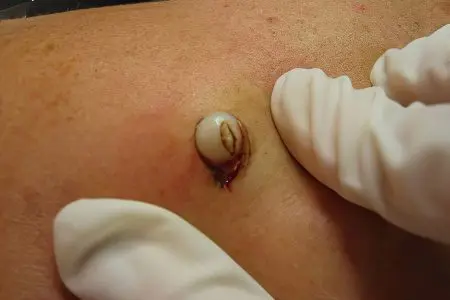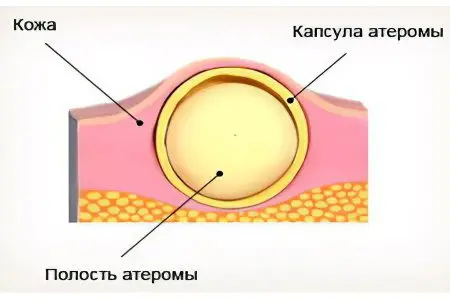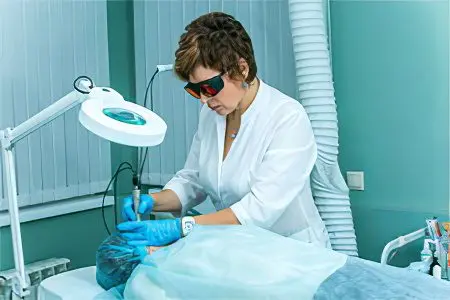Contents
Atheroma is a benign formation of the sebaceous gland. It is formed in case of blockage of the excretory duct, resulting in the formation of a cyst filled with detritus – sebum, particles of exfoliated epidermis. Since the gland does not stop functioning, the capsule is constantly increasing. Its tip rises above the surface of the skin, a pronounced cosmetic defect appears. Atheroma brings discomfort if it is constantly subjected to friction with clothing and mechanical pressure.
How does inflammation occur?

Lipids accumulating in the cyst capsule are a breeding ground for the reproduction of pathogenic microorganisms. After entering the atheroma cavity, they multiply and thereby trigger the inflammatory process.
Causes of infection:
An attempt to get rid of atheroma on your own, squeeze it out;
Failure to comply with hygiene rules;
Excessive production of testosterone by the body of a man or androgens by the body of a woman;
The use of synthetic clothing and the resulting increased sweating;
Trauma of the epidermis in the projection of atheroma.
With weakened immunity, secondary infection can occur when pathogenic organisms penetrate the atheroma capsule with blood flow from other foci of infection.
Clinical picture of festering atheroma

If the infectious process does not complicate the development of atheroma, it looks like a rounded formation raised above the skin. Its color differs from the color of the surrounding tissues by 1-2 shades; during palpation, a person does not experience any pain or negative sensations. At the top of the atheroma, you can sometimes find a black dot – a clogged mouth of the cyst.
After suppuration and inflammation, the following symptoms appear:
Hyperemia of tissues and their edema;
Sharp pain when pressing on the inflamed formation, aching pain the rest of the time;
An increase in the temperature of the skin surrounding the cyst;
Increase in general temperature;
An increase in atheroma in size;
Symptoms of intoxication of the body with the waste products of pathogenic bacteria (weakness, headache, nausea);
Enlargement of nearby lymph nodes.
A long-lasting inflammatory process can lead to ulceration of atheroma. The formed crust can move away, and then the contents of the inflamed atheroma are visible under the skin. Sometimes the cyst opens spontaneously, its contents come out, the intensity of the symptoms decreases somewhat. Nevertheless, the process of atheroma formation starts again. Relapse is facilitated by the fact that the cells of the capsule in which the cyst has formed give rise to the formation of a new formation.
Prognosis for the development of a festering cyst

To put it figuratively, any atheroma, even having a small size, is a kind of “time bomb”.
Any injury can damage the epidermis, and then the progressive inflammatory process forms the following complications:
Abscess;
Phlegmon, which forms a diffuse inflammation under the skin;
Thrombus formation is a possible cause of death.
This means that at the first signs of atheroma inflammation, you should seek the advice of a doctor. It can be a surgeon, a dermatologist.
Diagnostics
To diagnose atheroma, it is enough for a doctor to conduct a visual examination. It is important to differentiate atheroma from lipoma, hygroma, lymphadenitis or granuloma. In the stage of inflammation, atheroma is easily mistaken for a boil, inflammation of several small atheromas at the same time – for a pustular rash, ulceration – for a syphilitic ulcer.
In difficult cases, an ultrasound examination of atheroma is performed, as a result of which an image of a cyst cavity filled with pus is obtained in the image.
Treatment of festering atheroma

The only method of treating an inflamed formation is its radical removal with the help of surgical treatment. Despite the fact that modern methods such as laser and radio wave surgery are used to remove sebaceous cysts, inflamed atheroma is often removed in the traditional way using a conventional scalpel.
Removal of education takes place in 2 stages:
Opening of the abscess with removal of pus and remnants of the secretion of the gland;
Removal of the capsule in which atheroma is formed.
Between the stages, a course of treatment with antibacterial drugs prescribed by a doctor is carried out. Most often, modern effective antibiotics are prescribed: Sumamed, Azithromycin, Doxycycline, Lincomycin.
Opening and removal of inflamed atheroma is performed under local anesthesia. To do this, the doctor performing the manipulation performs several injections of anesthetic around the cyst. If it has reached a significant size, when it is removed, minor negative sensations may appear.
Removing the capsule of inflamed atheroma without damaging it is not always possible.
The operation is carried out in the following sequence:
Around the atheroma, two skin incisions are made;
The skin flap over the cyst is removed;
Surgical scissors are inserted under the cyst, separating it from the surrounding tissues;
The selected capsule is pulled out;
A ligature is applied to the surgical wound;
After 5-8 days, the sutures are removed, measures are taken to regenerate the scar tissue.
Usually, after the enucleation of a festering atheroma, a noticeable scar remains, to eliminate which one has to undergo plastic surgery.
Removal of education using laser surgery

A laser knife is used to remove inflamed and festering atheromas of a small size. Methods used in laser surgery:
photocoagulation – used to remove small inflamed atheromas (up to 5 mm). In this case, sutures are not required, after the postoperative scab falls off after 1-2 weeks, an area of skin without damage remains under it.
Excision of the cyst along with the capsule – used to remove formations 5-20 mm in diameter. First, an incision is made, then the capsule is separated from the surrounding tissues with a laser knife, evaporating the adhesion boundary with the surrounding structures. After the atheroma is released, it is removed, drainage is installed, and the wound is sutured. After a few days, the drainage is removed, the stitches are removed after 1-1,5 weeks. As a result of this manipulation, an inconspicuous scar is formed.
Vaporization (evaporation) of the capsule – used to remove atheroma over 20 mm in diameter. After opening the cyst and removing the contents from it, the surgical field is dried, the wound is stretched and the capsule shell is evaporated with a laser. At the end of the operation, a drainage tube is installed, sutures are applied for 1-1.5 weeks.
After using a laser knife, an inconspicuous suture remains, and the tissues surrounding the cyst are not injured.
Post-operative care

In order for the healing of the surgical wound to pass quickly and without complications, it is necessary to carry out regular dressings in a surgical hospital.
Possible care measures:
Washing the wound with hydrogen peroxide;
Applying an ointment with antiseptic properties (Levomekol);
Closing the wound with a sterile dressing.
After the edges of the wound are somewhat tightened, and the sutures are removed, instead of a bandage, medical glue BF-6 can be applied to it. Glue is used within 15-20 days after removal of the ligature.
The following signs indicate that wound healing proceeds with complications:
Redness of the skin around the surgical wound;
Temperature increase;
Feverish state;
The appearance of purulent discharge from the wound, an admixture of pus and blood;
Divergence of seams.
In case of any complication, you should immediately consult your doctor. If the removal was not carried out correctly, particles of the capsule remained, atheroma may reappear. This complication occurs in 3% of cases, corrected by a second operation.









